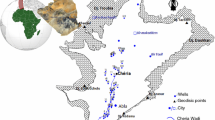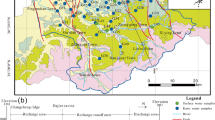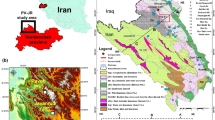Abstract
To determine the impact of natural factors and human activities on the hydrogeochemical evolution of karst groundwater, hydrochemical surveys were conducted in the Jinci spring area, north China. In the present work, a comprehensive method, including hydrochemistry, isotopes, statistical analysis and hydrochemical modeling, was applied to analyze the origin of karst groundwater, hydrochemical reactions, and the causes of SO42− pollution. Isotopic characteristics (2H and 18O) suggest that karst groundwater is majorly replenished by precipitation infiltration and surface water leakage from the exposed carbonate rock areas. The hydrochemical facies evolve from HCO3-Ca and HCO3-Ca·Mg in the recharge area, to HCO3·SO4-Ca·Mg and SO4·HCO3-Ca·Mg in the transitional area, and SO4-Ca and SO4-Ca·Mg in the discharge area. Naturally, dissolution or precipitation of calcite, dolomite, gypsum and halite, as well as cation exchange predominate the hydrochemical evolution. Due to long-term coal mining activities, acid mine drainage mixed with karst groundwater, resulting in strong SO42− contamination of groundwater in the spring area. According to 34S isotope fractionation, SO42− is mainly from gypsum dissolution (64%), followed by pyrite oxidation (36%). In addition, the mixing processes, rock–water interactions, cation exchange, and dedolomitization were identified and confirmed by hydrochemical modeling with PHREEQC program. The findings of this work are meaningful for groundwater sustainable utilization and contamination management.











Similar content being viewed by others
Data availability
The datasets generated during and/or analyzed during the current study are available from the corresponding author on reasonable request.
References
Ayuba R, Tijani MN, Snow D (2019) Hydrochemistry and stable isotopes (18O and 2H) characteristics of groundwater in Lokoja and its environs, central Nigeria. Environ Earth Sci 78:1–15. https://doi.org/10.1007/s12665-019-8582-8
Bajjali W (2004) Recharge mechanism and hydrochemistry evaluation of groundwater in the Nuaimeh area, Jordan, using environmental isotope techniques. Hydrogeol J 14:180–191. https://doi.org/10.1007/s10040-004-0352-2
Bello M, Ketchemen-Tandia B, Nlend B, Huneau F, Fouepe A, Fantong WY, Ngo Boum-Nkot S, Garel E, Celle-Jeanton H (2019) Shallow groundwater quality evolution after 20 years of exploitation in the southern Lake Chad: hydrochemistry and stable isotopes survey in the far north of Cameroon. Environ Earth Sci. https://doi.org/10.1007/s12665-019-8494-7
Bureau of Technical Supervision of the People's Republic of China. Standard for groundwater quality (GB/T 14848–2017). Beijing: China Standard Press, 2018. (in Chinese)
Christofi C, Bruggeman A, Kuells C, Constantinou C (2020) Hydrochemical evolution of groundwater in gabbro of the Troodos Fractured Aquifer. A comprehensive approach. Appl Geochem. https://doi.org/10.1016/j.apgeochem.2020.104524
Craig H (1961) Isotopic variation in meteoric waters. Science 133:1702–1703. https://doi.org/10.1126/science.133.3465.1702
Cuoco E, Colombani N, Darrah TH, Mastrocicco M, Tedesco D (2017) Geolithological and anthropogenic controls on the hydrochemistry of the Volturno river (Southern Italy). Hydrol Process 31:627–638. https://doi.org/10.1002/hyp.11055
Favas PJC, Sarkar SK, Rakshit D, Venkatachalam P, Prasad MNV (2016) Acid mine drainages from abandoned mines. Environ Mater Waste. https://doi.org/10.1016/B978-0-12-803837-6.00017-2
Gan Y, Zhao K, Deng Y, Liang X, Ma T, Wang Y (2018) Groundwater flow and hydrogeochemical evolution in the Jianghan Plain, central China. Hydrogeol J 26:1609–1623. https://doi.org/10.1007/s10040-018-1778-2
Guma BE, Muwanga A, Owor M (2021) Hydrogeochemical evolution and contamination of groundwater in the Albertine Graben, Uganda. Environ Earth Sci. https://doi.org/10.1007/s12665-021-09587-6
He X, Wu J, Guo W (2019) Karst spring protection for the sustainable and healthy living: the examples of Niangziguan spring and Shuishentang spring in Shanxi, China. Expos Heal 11:153–165. https://doi.org/10.1007/s12403-018-00295-4
Huang G, Sun J, Zhang Y, Chen Z, Liu F (2013) Impact of anthropogenic and natural processes on the evolution of groundwater chemistry in a rapidly urbanized coastal area, South China. Sci Total Environ 463–464:209–221. https://doi.org/10.1016/j.scitotenv.2013.05.078
Huang H, Chen Z, Wang T, Zhang L, Zhou G, Sun B, Wang Y (2019) Characteristics and processes of hydrogeochemical evolution induced by long-term mining activities in karst aquifers, southwestern China. Environ Sci Pollut R 26:30055–30068. https://doi.org/10.1007/s11356-019-05984-4
Huang X, Ping J, Leng W, Yu Y, Zhang M, Zhu Y (2021) A study on groundwater recharge in the Anyanghe River alluvial fan, North China Plain, based on hydrochemistry, stable isotopes and tritium. Hydrogeol J 29:2149–2170. https://doi.org/10.1007/s10040-021-02369-1
Jean-Baptiste J, Salle LGL, C, Verdoux P, (2020) Use of mixing models to explain groundwater quality time and space variation in a narrowed fluctuating alluvial aquifer. Appl Geochem. https://doi.org/10.1016/j.apgeochem.2020.104700
Jia Z, Zang H, Zheng X, Zhang P (2015) Research on characteristics of hydrogen and oxygen isotopes of precipitation in Taiyuan area. Journal of Water Resources & Water Engineering 26(02):22–25. https://doi.org/10.11705/j.issn.1672-643X.2015.02.05(inChinese)
Jia Z, Zang H, Hobbs P, Zheng X, Xu Y, Wang K (2017) Application of inverse modeling in a study of the hydrogeochemical evolution of karst groundwater in the Jinci Spring region, northern China. Environ Earth Sci. https://doi.org/10.1007/s12665-017-6631-8
Kim D-M, Oh YS, Lee J-S (2020) δ34S and δ18O of sulfates and Zn/Cd ratios reveal the cause of soil and groundwater contamination in metalliferous mining areas. J Geochem Explor. https://doi.org/10.1016/j.gexplo.2019.106437
Kumar S, Venkatesh AS, Singh R, Udayabhanu G, Saha D (2018) Geochemical signatures and isotopic systematics constraining dynamics of fluoride contamination in groundwater across Jamui district, Indo-Gangetic alluvial plains, India. Chemosphere 205:493–505. https://doi.org/10.1016/j.chemosphere.2018.04.116
Li P (2018) Mine water problems and solutions in China. Mine Water Environ 37:217–221
Li Q, Zhou J, Zhou Y, Bai C, Tao H, Jia R, Ji Y, Yang G (2014) Variation of groundwater hydrochemical characteristics in the plain area of the Tarim Basin, Xinjiang Region, China. Environ Earth Sci 72:4249–4263. https://doi.org/10.1007/s12665-014-3320-8
Li P, Wu J, Tian R, He S, He X, Xue C, Zhang K (2018) Geochemistry, hydraulic connectivity and quality appraisal of multilayered groundwater in the Hongdunzi Coal Mine, Northwest China. Mine Water Environ 37:222–237. https://doi.org/10.1007/s10230-017-0507-8
Li C, Gao X, Liu Y, Wang Y (2019) Impact of anthropogenic activities on the enrichment of fluoride and salinity in groundwater in the Yuncheng Basin constrained by Cl/Br ratio, δ18O, δ2H, δ13C and δ7Li isotopes. J Hydrol. https://doi.org/10.1016/j.jhydrol.2019.124211
Lin CY, Abdullah MH, Praveena SM, Yahaya AHB, Musta B (2012) Delineation of temporal variability and governing factors influencing the spatial variability of shallow groundwater chemistry in a tropical sedimentary island. J Hydrol 432–433:26–42. https://doi.org/10.1016/j.jhydrol.2012.02.015
Liu F, Wang S, Wang L, Shi L, Song X, Yeh T-CJ, Zhen P (2019) Coupling hydrochemistry and stable isotopes to identify the major factors affecting groundwater geochemical evolution in the Heilongdong Spring Basin, North China. J Geochem Explor. https://doi.org/10.1016/j.gexplo.2019.106352
Lu S, Chen J, Zheng X, Liang Y, Jia Z, Li X (2020) Hydrogeochemical characteristics of karst groundwater in Jinci spring area, North China. Carbonate Evaporite. https://doi.org/10.1007/s13146-020-00602-8
Lv C, Ling M, Wu Z, Gu P, Guo X, Di D (2019) Analysis of groundwater variation in the Jinci Spring area, Shanxi Province (China), under the influence of human activity. Environ Geochem Health 41:921–928. https://doi.org/10.1007/s10653-018-0189-6
Morales-Casique E (2012) Mixing of groundwaters with uncertain end-members: case study in the Tepalcingo-Axochiapan aquifer, Mexico. Hydrogeol J 20:605–613. https://doi.org/10.1007/s10040-011-0826-y
Morán-Ramírez J, Ledesma-Ruiz R, Mahlknecht J, Ramos-Leal JA (2016) Rock–water interactions and pollution processes in the volcanic aquifer system of Guadalajara, Mexico, using inverse geochemical modeling. Appl Geochem 68:79–94. https://doi.org/10.1016/j.apgeochem.2016.03.008
Moya CE, Raiber M, Taulis M, Cox ME (2015) Hydrochemical evolution and groundwater flow processes in the Galilee and Eromanga basins, Great Artesian Basin, Australia: a multivariate statistical approach. Sci Total Environ 508:411–426. https://doi.org/10.1016/j.scitotenv.2014.11.099
Nassery HR, Alijani F (2014) The Effects of an abandoned coal mine on groundwater quality in the Science and Research Park (SRP) of Shahid Beheshti University, Zirab (Northern Iran). Mine Water Environ 33:266–275. https://doi.org/10.1007/s10230-014-0266-8
Niculescu BM, Andrei G (2021) Application of electrical resistivity tomography for imaging seawater intrusion in a coastal aquifer. Acta Geophys 69:613–630. https://doi.org/10.1007/s11600-020-00529-7
Pacheco-Martínez J, Hernandez-Marín M, Burbey TJ, González-Cervantes N, Ortíz-Lozano JÁ, Zermeño-De-Leon ME, Solís-Pinto A (2013) Land subsidence and ground failure associated to groundwater exploitation in the Aguascalientes Valley, México. Eng Geol 164:172–186. https://doi.org/10.1016/j.enggeo.2013.06.015
Parkhurst DL, Appelo CAJ (2013) Description of input and examples for PHREEQC version 3—A computer program for speciation, batch-reaction, one-dimensional transport, and inverse geochemical calculations. US Geol Surv Tech Methods. https://doi.org/10.3133/tm6A43
Piper AM (1944) A graphic procedure in the geochemical interpretation of water analysis. Trans Am Geophys Union 25:914–923
Qiao X, Li G, Li M, Zhou J, Du J, Du C, Sun Z (2010) Influence of coal mining on regional karst groundwater system: a case study in West Mountain area of Taiyuan City, northern China. Environ Earth Sci 64:1525–1535. https://doi.org/10.1007/s12665-010-0586-3
Rajmohan N, Amarasinghe UA (2016) Groundwater quality issues and management in Ramganga Sub-Basin. Environ Earth Sci. https://doi.org/10.1007/s12665-016-5833-9
Rodríguez-Galán M, Baena-Moreno FM, Vázquez S, Arroyo-Torralvo F, Vilches LF, Zhang Z (2019) Remediation of acid mine drainage. Environ Chem Lett 17:1529–1538. https://doi.org/10.1007/s10311-019-00894-w
Ruiz-Constán A, Ruiz-Armenteros AM, Lamas-Fernández F, Martos-Rosillo S, Delgado JM, Bekaert DPS, Sousa JJ, Gil AJ, Caro Cuenca M, Hanssen RF, Galindo-Zaldívar J, Sanz de Galdeano C (2016) Multi-temporal InSAR evidence of ground subsidence induced by groundwater withdrawal: the Montellano aquifer (SW Spain). Environ Earth Sci. https://doi.org/10.1007/s12665-015-5051-x
Salem ZE, Atwia MG, El-Horiny MM (2015) Hydrogeochemical analysis and evaluation of groundwater in the reclaimed small basin of Abu Mina. Egypt Hydrogeol J 23:1781–1797. https://doi.org/10.1007/s10040-015-1303-9
Song PP (2021) Study on the chemical evolution rule and formation mechanism of groundwater in Jinci Spring Area, Hebei GEO University. (in Chinese)
Tang C, Jin H, Liang Y (2021) Using isotopic and hydrochemical indicators to identify sources of sulfate in karst groundwater of the Niangziguan spring field, China. Water. https://doi.org/10.3390/w13030390
Tran TQ, Banning A, Wisotzky F, Wohnlich S (2020) Mine water hydrogeochemistry of abandoned coal mines in the outcropped Carboniferous, Ruhr Area, Germany. Environ Earth Sci. https://doi.org/10.1007/s12665-020-8821-z
Wang H, Jiang XW, Wan L, Han G, Guo H (2015) Hydrogeochemical characterization of groundwater flow systems in the discharge area of a river basin. J Hydro 527:433–441. https://doi.org/10.1016/j.jhydrol.2015.04.063
Wang Y, Ma T, Gao X, Pan H, Liu Q, Hu X, Cheng J, Zhang J (2019) Research report on jinci spring reflow project. China University of Geosciences, Wuhan
Yang Y, Guo T, Jiao W (2018) Destruction processes of mining on water environment in the mining area combining isotopic and hydrochemical tracer. Environ Pollut 237:356–365. https://doi.org/10.1016/j.envpol.2018.02.002
Yasin D, Kargın M (2021) Hydrogeochemical and isotopic characteristics of water resources in Çubuk-Melikşah (Ankara/Turkey). Environ Earth Sci. https://doi.org/10.1007/s12665-021-09813-1
Zang H, Zheng X, Jia Z, Chen J, Qin Z (2014) The impact of hydrogeochemical processes on karst groundwater quality in arid and semiarid area: a case study in the Liulin spring area, north China. Arab J Geosci 8:6507–6519. https://doi.org/10.1007/s12517-014-1679-1
Zang H, Zheng X, Qin Z, Jia Z (2015) A study of the characteristics of karst groundwater circulation based on multi-isotope approach in the Liulin spring area, North China. Isot Environ Healt S 51:271–284. https://doi.org/10.1080/10256016.2015.987275
Zhang X, Li X, Gao X (2016) Hydrochemistry and coal mining activity induced karst water quality degradation in the Niangziguan karst water system, China. Environ Sci Pollut R 23:6286–6299. https://doi.org/10.1007/s11356-015-5838-z
Zhang H, Ke S, Zhang S, Shao J, Chen H (2020a) Reactive transport modeling of pollutants in heterogeneous layered paddy soils: a) Cadmium migration and vertical distributions. J Contam Hydrol 235:103735. https://doi.org/10.1016/j.jconhyd.2020.103735
Zhang H, Xu G, Zhan H, Chen X, Liu M, Wang M (2020b) Identification of hydrogeochemical processes and transport paths of a multi-aquifer system in closed mining regions. J Hydrol. https://doi.org/10.1016/j.jhydrol.2020.125344
Zhang Z, Xu Y, Wang Z, Zhang Y, Zhu X, Guo L, Zheng Q, Tang L (2020c) Ecological restoration and protection of Jinci Spring in Shanxi, China. Arab J Geosci. https://doi.org/10.1007/s12517-020-05729-5
Zhang Z, Wang Z, Xu Y, Zhang Y, Guo L, Zheng Q, Tang L (2020d) Quantitative study on the changes of karst groundwater level and hydrochemistry in Jinci Spring catchment, Shanxi. China Expos Health 12(3):513–525. https://doi.org/10.1007/s12403-019-00317-9
Zhang J, Chen L, Hou X, Lin M, Ren X, Li J, Zhang M, Zheng X (2021) Multi-isotopes and hydrochemistry combined to reveal the major factors affecting Carboniferous groundwater evolution in the Huaibei coalfield North China. Sci Total Environ 791:148420. https://doi.org/10.1016/j.scitotenv.2021.148420
Acknowledgements
The sampling project was supported by Institute of Karst Geology, Chinese Academy of Geological Sciences, China. We thank Yongping Liang and Zhenxing Jia for their help and technical support.
Author information
Authors and Affiliations
Contributions
All authors contributed to the study conception and design. SL: conceptualization, methodology, software, data processing, writing—original draft preparation. NZ: conceptualization, methodology, writing—review and editing. SJ: methodology, software, writing—review and editing. XZ: supervision, software, validation, writing—review and editing. All authors read and approved the final manuscript.
Corresponding author
Ethics declarations
Conflict of interest
The authors declare that they have no known competing financial interests or personal relationships that could have appeared to influence the work reported in this paper.
Additional information
Publisher's Note
Springer Nature remains neutral with regard to jurisdictional claims in published maps and institutional affiliations.
Rights and permissions
Springer Nature or its licensor (e.g. a society or other partner) holds exclusive rights to this article under a publishing agreement with the author(s) or other rightsholder(s); author self-archiving of the accepted manuscript version of this article is solely governed by the terms of such publishing agreement and applicable law.
About this article
Cite this article
Lu, S., Zhou, N., Jiang, S. et al. Combining hydrochemistry and environmental isotopes to study hydrogeochemical evolution of karst groundwater in the Jinci spring area, North China. Carbonates Evaporites 38, 36 (2023). https://doi.org/10.1007/s13146-023-00859-9
Accepted:
Published:
DOI: https://doi.org/10.1007/s13146-023-00859-9




